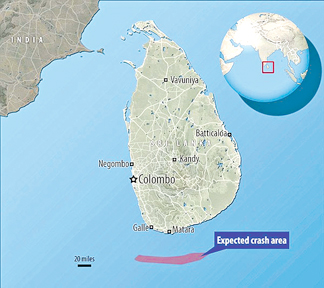The landing of a piece of cosmic debris
by Phil Plait
Before I even start: I know some people get very nervous about
stories like this. Let me assure you, we're safe. Read on, and don't
panic!
 |
|
Pic: Courtesy
heinertia.com |
For one of the very few times in history, humans have spotted a piece
of cosmic debris on an impact course with Earth before it enters our
atmosphere and burns up.
The object, temporarily called WT1190F, will enter Earth's atmosphere
and burn up on November 13 around 06:20 UTC (01:20 Eastern US time) near
Sri Lanka.
And it almost certainly will disintegrate harmlessly in our air. It's
too small and light to reach the ground. We've seen objects coming in
from space that have hit us before-specifically the tiny asteroids 2008
TC3 and 2014 AA-but this time, astronomers are pretty sure it's not an
asteroid at all but actually a rocket booster or fuel tank from a
previous launch!
Orbit around Earth
WT1190F was discovered on October 3, just a few weeks ago, by
astronomer Rose Matheny in data taken by the Catalina Sky Survey. It's
very unusual. For one thing it's very faint, and therefore quite small,
and for another, it's in orbit around the Earth! Right away this makes
it overwhelmingly unlikely to be an actual asteroid; an asteroid on an
impact trajectory with Earth will almost always be coming from deep
space.
It orbits the Earth on an extremely elliptical path, which is also
typical for used-up rocket motors. It orbits once every three weeks or
so, getting as far away as about 650,000 km (more than 1.5 times as far
as the Moon). Again, this is far more like a rocket booster than a
natural asteroid. Given that orbit, it may very well be from a recent
Moon mission.
According to the European Space Agency's Near-Earth Asteroid group,
it was also seen in Catalina data from 2013, allowing a pretty good
orbit determination (the longer you observe an object, the better you
can figure out its orbit). Over time, the orbits of objects can change
due to a number of factors, including (seriously) pressure from
sunlight.
 |
|
A mysterious space object
is on a collision course with Earth on November 13.
Pic: Courtesy i.ytimg.com |
By measuring this effect, astronomers have calculated that WT1190F
has an incredibly low density, about 10 percent that of water. No known
asteroid has a density this low, but it makes perfect sense if it's a
hollow object like a booster or fuel tank, probably just a couple of
meters across.
This is why we can be confident that it'll burn up harmlessly. Its
low density and small size means it'll slow very rapidly once it
contacts Earth's atmosphere, creating a lot of heat that should break it
up and vapourize it. I'll be careful and say that some pieces may
survive re-entry and hit the Earth's surface, but they're likely to be
very small.
Note that the impact is expected to occur about 100 km off the
southern tip of Sri Lanka over the Indian Ocean (since the Earth's
surface is three-fourths water, most impacts occur over the ocean). That
prediction may be off by 10-20 km or so (atmospheric drag makes pinpoint
precision impossible with such objects re-entering), but still, it seems
very likely that any pieces that manage to survive will fall into the
water.
Rapid heating up
 |
|
Pic: Courtesy newscurry |
It'll be very faint right up until it burns up, far fainter than a
human eye can see. Once it enters Earth's atmosphere though it'll
rapidly heat up, glow, and should put on quite a show for people in the
area. I hope we get good photos and video! If you live in Sri Lanka and
catch it, please contact me!
If you are in that area, you'll need clear skies above you and to the
south to see it. When it happens, it'll be moving faster than a
satellite would across the sky, but slower than a typical meteor, and
may actually look like it's shedding sparks as bits and pieces of it
melt off and blow away. To be clear, I'm not at all worried about this,
and in fact I'm quite excited we may get a chance to see it! It's very
rare to find an object before it impacts, and in the previous two cases
they were discovered only about a single day before they burned up.
This time, we have a few weeks, so hopefully there will be more
observations of it. That's important: An object under the influence of
non-gravitational forces (like sunlight pressure) can have a difficult
orbit to predict, so the more observations of it we have, the better
we'll understand just how these forces work on small objects.
This will also be a nice shakedown of the systems in place that alert
us to any more dangerous incoming objects. Testing those out under safe
circumstances like these strikes me as a pretty good idea, too.
About the author:
Phil Plait writes Slate's Bad Astronomy blog and is an astronomer,
public speaker, science evangelizer and author of Death From the Skies!
-slate.com
 |

